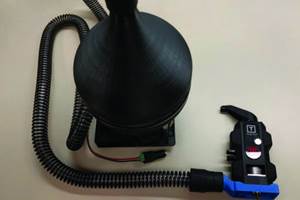Reducing Disposal Cost for Separator Vacuums
This filtration company addresses an overlooked AM safety and environmental compliance problem.
Share
Read Next
Additive manufacturing growth has been fueled by the increased multi-industry adoption of additive metal manufacturing. However, with this increase in metal systems comes more metal powder waste by-products. A small amount of metal powder sitting in a container may notseem like much, but it potentially is significant from both a safety and cost perspective.
Few talk about this. When a metal additive machine arrives, it might be that everyone is amazed at the work the laser performs, but no one says anything about the back end of the process, the hazardous remnants that are left and what should be done with them. Perhaps the most significant of these by-products is the wastewater from metal-particle-saturated liquid-separator vacuums.
Common practice is to use liquid separator vacuums to clean up unwanted metal powder from the work area. Operators often clean out their metal printing equipment with a wet separator vacuum unit that has a spigot on the back end from which water carrying metal powders flows. The vacuum's wastewater requires regular disposal, while the vacuum needs consistent maintenance and cleaning. Operators traditionally use a water hose to force the sediment through the drain opening for this cleaning, creating more wastewater.
Disposing of the waste from separator vacuums is costly. Larger corporations abide by proper hazardous waste procedures by putting the remnants of the wet separator in a 55-gallon drum, weighing it and disposing of it as hazardous waste at up to $44.00 per pound. Considering the number of machines and amount of materials that may be present on the shop floor quickly reveals how the numbers can add up. A new wet separator sequestration and maintenance solution aims to address this problem.
Six months ago, Ed Tackett, Director of Educational Programs at the UL Additive Manufacturing Competency Center (UL AMCC) in Louisville, Kentucky, contacted Kinetic Filtration, a Kentucky-based filter manufacturer. Tackett was looking for a solution for recycling metal powder picked up by the specialized wet separation system used in metal additive manufacturing. Kinetic President David Virgin observed this problem firsthand during one of the many training classes held at the UL AMCC.
“It only took a week of servicing the wet separator myself to realize the extent of the problem. Then I got to work on a solution that incorporated various trade secrets developed at Kinetic. The resulting design allows for a large amount of valuable metallic particulate to be picked up in a short amount of time. I’ve seen up to 5 pounds of metal collected in a minute,” says Virgin.
Virgin’s industrial manufacturing background helped him develop the “Hazo-loc,” a unit that connects to the wet separator and sequesters the metal powders from the waste stream. The unit is part of a wet separator maintenance starter kit, which includes a blue 30-gallon drum with a removable lid so the operator has a quick visual inspection of the filtered water; a custom drain funnel for the top of the drum; a pressurized and easily directed water rinse/spray unit; and quick-release clamps. The system requires no tools, according to Virgin, and is recommended to be used on a weekly maintenance schedule. Once it attaches to the end of the wet separator drain, the user kicks open the nozzle and water flows out, allowing for the removal of grime, dirt, condensate and hazardous metal particulate. The unit is adaptable to all wet separator systems on the market regardless of the draining mechanism.
The sprayer included in the starter kit replaces the use of a garden hose to clean out the wet separator. According to Virgin, operators traditionally use a water hose to force the sediment through the drain opening while cleaning their liquid separator vacuums. “The common garden hose method not only allows gallons of water to be wasted and charged as hazardous waste throughout the cleaning process, it also prohibits precise cleaning of the separator because the operator cannot direct the flow of water with pinpoint accuracy using a garden hose. Therefore, the sprayer is a more effective and efficient tool,” Virgin explains. According to Virgin, this precise, directed nozzle approach has a lower flow and uses less water. Once the operator has finished the cleaning process, the unit can be removed from the wet separator and then simply allowed to dry in the sun.
“Proper use of the unit, along with regular wet separator maintenance can and has resulted in recyclability of fine metal particulate, potentially no liquid hazardous waste fees, reduced wet separator maintenance time, minimal employee exposure to potentially harmful substances and compliance with local, state and federal regulations regarding waste disposal,” says Virgin. It is important to note that even after proper use of this system, the leftover water must be tested to ensure that it meets the requirements of gray water in the user’s area. To date, the unit is patented and has been tested extensively with a final achievement of gray water for the cities of Louisville and Dayton.
Kinetic also developed a fire retardant fume filter to help prevent fires in 3D metal printers. According to Virgin, not only is this unit safer than other filters, but also allows three to four times the amount of air to pass while maintaining its efficiency in single-digit micron-rated particulate removal. The filter is self-extinguishing, and when burned, it does not produce CO2. A related product is a fire retardant outlet bag for traditional wet separators, further helping to create a safe environment for AM metals users.
Related Content
Chromatic 3D Materials' RX-AM Free of Volatile Isocyanates
RX-AM platform includes software and RX-Flow printers for use in standard and custom configurations.
Read MoreSLM Solutions, Assembrix Work to Ensure Secure Remote Printing
Following the integration of Assembrix VMS software into SLM Solutions’ machines, both companies are now working to ensure the enhanced safety and full protection of customers' intellectual property, which is made possible through the utilization of blockchain and encryption technologies.
Read MoreNIOSH Publishes 3D Printing Safety Guide for Nonindustrial Settings
NIOSH has published a 3D printing safety guide for small businesses and other additive manufacturing users such as makerspace users, schools, libraries and small businesses.
Read MoreDesktop Metal’s Production System P-1 Features Optional Reactive Safety Kit
The kit features ATEX-rated components, as well as critical hardware and software updates that enable safe printing of ultrafine powders.
Read MoreRead Next
Bike Manufacturer Uses Additive Manufacturing to Create Lighter, More Complex, Customized Parts
Titanium bike frame manufacturer Hanglun Technology mixes precision casting with 3D printing to create bikes that offer increased speed and reduced turbulence during long-distance rides, offering a smoother, faster and more efficient cycling experience.
Read MoreCrushable Lattices: The Lightweight Structures That Will Protect an Interplanetary Payload
NASA uses laser powder bed fusion plus chemical etching to create the lattice forms engineered to keep Mars rocks safe during a crash landing on Earth.
Read MoreAlquist 3D Looks Toward a Carbon-Sequestering Future with 3D Printed Infrastructure
The Colorado startup aims to reduce the carbon footprint of new buildings, homes and city infrastructure with robotic 3D printing and a specialized geopolymer material.
Read More

























